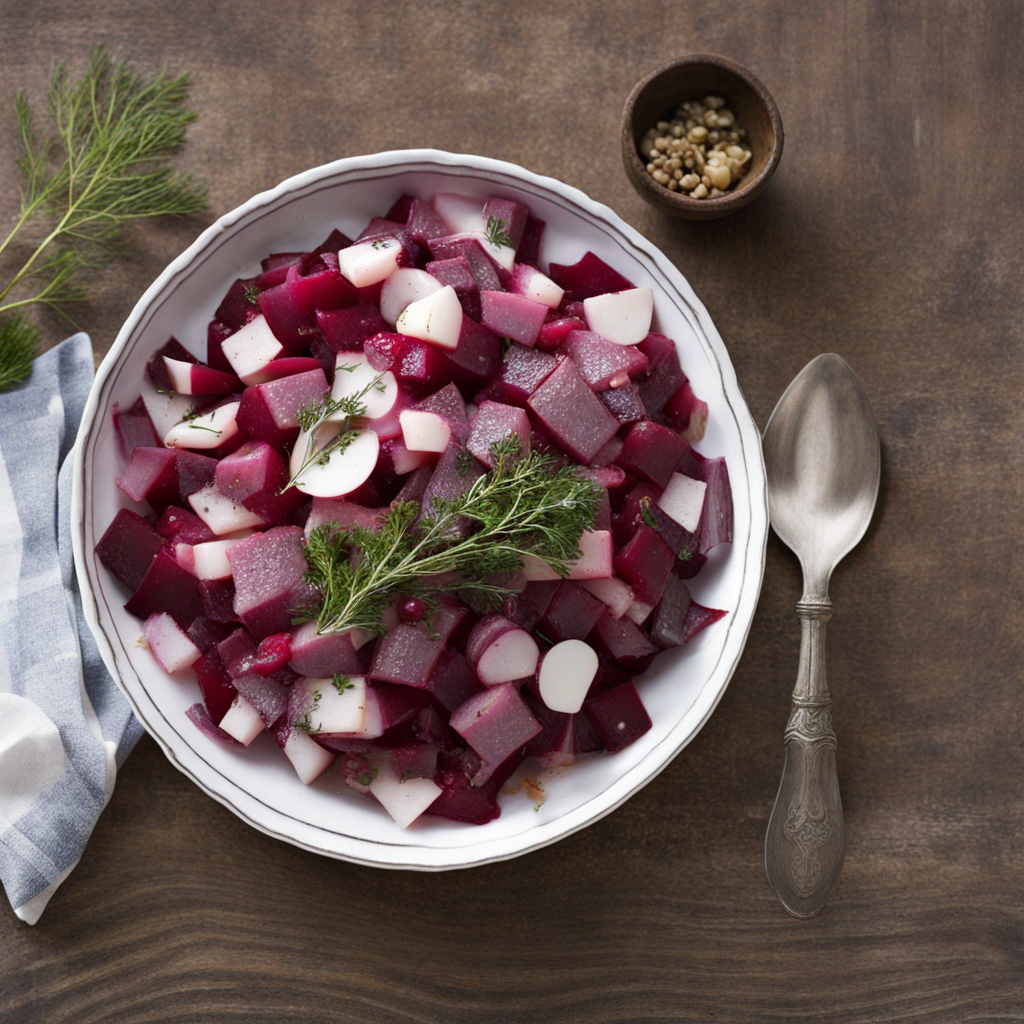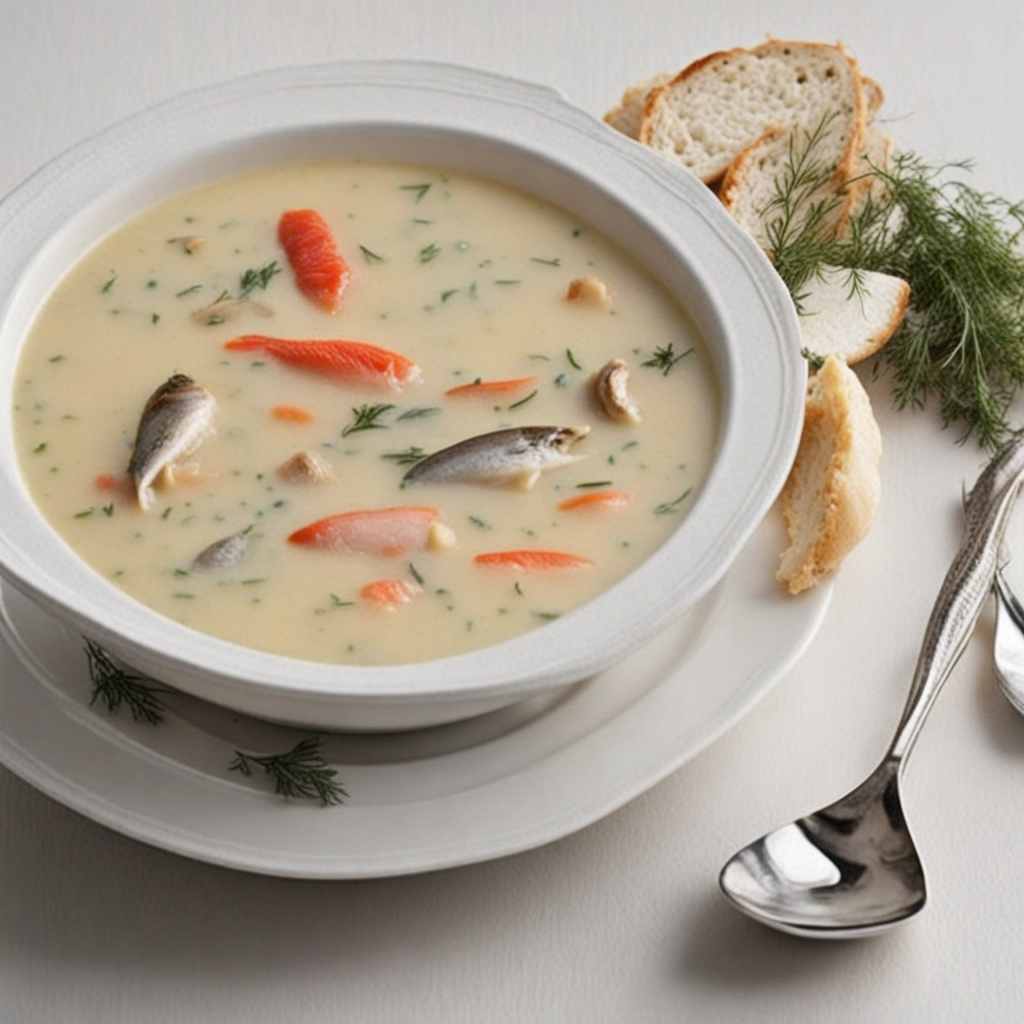Swedish Turnip Casserole
Swedish Turnip Casserole, also known as "Kålpudding," is a delightful dish that showcases the humble turnip in a comforting and hearty way. The casserole features layers of tender turnip slices, which are often complemented by a mix of ground meat, typically beef or pork, seasoned with a blend of spices such as nutmeg and allspice. The turnips lend a subtle sweetness and earthy flavor to the dish, balancing perfectly with the savory meat, creating a harmonious blend of textures and tastes that warms the heart and soul. As the casserole bakes, the flavors meld beautifully, creating a rich, aromatic experience that invites you to take a bite. The golden-brown top, often achieved through a sprinkle of breadcrumbs or a touch of cream, adds a delightful crunch that contrasts with the softness of the turnips and meat underneath. Each spoonful reveals a comforting combination that embodies the essence of traditional Swedish home cooking, making it a beloved choice for family gatherings or chilly evenings. In addition to its wonderful flavor, Swedish Turnip Casserole is often served with a side of lingonberry sauce, which adds a tangy brightness that elevates the dish even further. This pairing not only enhances the overall taste but also reflects the Scandinavian tradition of balancing rich flavors with tart accompaniments. Whether enjoyed as a main course or as part of a festive spread, this casserole is a must-try for anyone looking to explore the delicious and unique culinary heritage of Sweden.
How It Became This Dish
The History of Rotmos: Sweden's Root Vegetable Mash Rotmos, a traditional Swedish dish, is a comforting mash made primarily from root vegetables, most notably rutabaga (known as "kålrot" in Swedish) and potatoes. This dish not only represents the heart of Swedish culinary tradition but also embodies the resilience and resourcefulness of the Swedish people throughout history. Its origins, cultural significance, and evolution over time paint a vivid picture of a nation shaped by its climate, agriculture, and social fabric. #### Origins of Rotmos The roots of rotmos can be traced back to Sweden's agrarian past, where subsistence farming was essential for survival. The climate, characterized by long winters and short growing seasons, necessitated the cultivation of hearty root vegetables that could withstand the harsh conditions. Rutabaga, a cruciferous vegetable believed to have emerged from a cross between the turnip and the wild cabbage, became a staple in the Nordic diet. Its ability to thrive in cold climates made it a reliable source of nutrition during the long winters when fresh produce was scarce. Historically, rotmos was a dish born from necessity. Peasant families, who relied heavily on what they could grow, often made use of whatever root vegetables were available. The mash would typically combine rutabaga with potatoes, which were introduced to Sweden in the late 18th century. Potatoes were initially met with skepticism, but they quickly gained popularity because of their versatility and higher yield compared to other crops. #### Cultural Significance Rotmos is more than just a comforting dish; it is a symbol of Swedish cultural identity. In rural Sweden, it was often served during the winter months, a time when hearty, caloric foods were essential to maintain energy levels in the face of cold temperatures. Rotmos was particularly popular during the Christmas season, often served alongside traditional dishes such as cured meats and herring. This communal aspect of dining, where families would gather around the table to enjoy a warm meal, reinforced social bonds and a sense of belonging. In Swedish folklore, rotmos also held a place in the agricultural calendar, particularly during the harvest season. It was customary for families to celebrate the end of the harvest with feasting, and rotmos, made from freshly harvested rutabagas and potatoes, would often take center stage. The dish served as a reminder of the bounty of the earth and the hard work put into cultivating it. As the industrial revolution progressed in the 19th century, the rural way of life began to change. Urbanization brought about new food trends and a shift in dietary habits. However, rotmos managed to retain its position in Swedish cuisine, often celebrated in cookbooks and home kitchens as a symbol of traditional Swedish cooking. The dish remained a staple in many households, particularly in the provinces of Skåne and Värmland, where it was frequently featured in local festivals and gatherings. #### Development Over Time In the 20th century, rotmos underwent several transformations, reflecting broader changes in Swedish society. With the rise of convenience foods and the availability of a more diverse range of ingredients, many traditional dishes became simplified or modified. However, rotmos remained a beloved comfort food, often prepared from scratch by families who valued their culinary heritage. In contemporary Sweden, rotmos has seen a resurgence as part of the growing interest in traditional and local foods. As Swedes become increasingly aware of the importance of sustainable eating, there has been a move towards utilizing local, seasonal produce. Organic farming practices have also contributed to the revitalization of root vegetables, making rutabaga and potatoes more accessible to the modern consumer. The way rotmos is prepared has also evolved. While the classic version consists of a simple mash, contemporary cooks often experiment with additional ingredients. Variations may include the addition of carrots, parsnips, or even spices like nutmeg to enhance the flavor profile. Some modern recipes even incorporate dairy, such as cream or butter, to create a creamier texture. This evolution reflects a broader trend in the culinary world, where traditional dishes are reinterpreted to suit contemporary palates while still honoring their roots. #### Rotmos in Modern Swedish Cuisine Today, rotmos is often served as a side dish accompanying hearty meat dishes, such as meatballs (köttbullar), pork, or game meats. It remains a staple in many Swedish households, especially during festive occasions. Its warming, comforting nature makes it an excellent choice for gatherings, where it can be enjoyed by people of all ages. In restaurants, rotmos has been reintroduced to menus as part of a movement to celebrate traditional Swedish cuisine, often presented with a modern twist that highlights the dish's rustic origins while appealing to contemporary tastes. The cultural significance of rotmos extends beyond its culinary presence. It is a dish that connects generations, with recipes often passed down from grandmothers to mothers and children, preserving not only the method of preparation but also the stories and memories associated with it. In this way, rotmos serves as a living testament to Swedish heritage, embodying the values of resilience, community, and sustainability that are deeply ingrained in Swedish culture. #### Conclusion Rotmos is more than just a simple mash of root vegetables; it is a dish that encapsulates the history, culture, and identity of Sweden. From its origins in the agrarian society to its place in modern Swedish kitchens, rotmos has adapted and evolved while remaining a cherished symbol of comfort and tradition. As Sweden continues to embrace its culinary heritage, rotmos stands as a reminder of the importance of food in shaping community, identity, and history, inviting both old and new generations to gather around the table and share in its warmth.
You may like
Discover local flavors from Sweden







